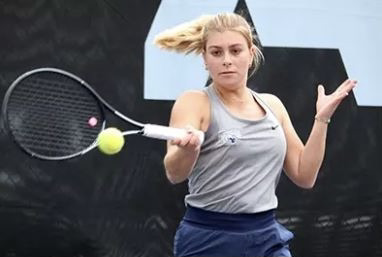Terrapins’ teamwork in sync
4 min readWarning: Attempt to read property "post_excerpt" on null in /home/bgonline/public_html/wp-content/themes/newsphere-pro/inc/hooks/hook-single-header.php on line 65
Sparkles, lipstick, and gold and silver colors dominate the poolside view as young women in brightly colored swimsuits affix glittery head pieces to tightly wound buns.
In lieu of swim caps, the swimmers use a product called Knox, mixed with hot water and allowed to set to keep their hair out of their faces. Gooey at first, it dries hard like a helmet—but once they start swimming, the heat from their bodies starts to melt it again.
“The putting up of your hair process is grueling,” said senior Kristina Scrimshaw. “It’s like hot glue and it burns if you get it on your skin.”
The pool empties as five teams prepare for the first event of the Southern Regional Synchronized Swimming Collegiate Championship. The UMW Terrapins are hosting the competition for the first time, according to Director of Campus Recreation Mark Mermelstein.
Practice
Three days earlier, I had my first exposure to synchronized swimming at the Terrapin’s Thursday-night practice.
“Ok guys, how about we swim in our sparkly suits,” team president senior Dana Gadeken suggests as they are getting changed in their row of the Goolrick Fitness Center locker room.
They don suits of metallic blues, purples and oranges.
They spread out their mats by the pool and fold themselves into contortionist-like exercises, chatting as they bend their knees into butterfly stretches and raise their legs over their heads.
The splits are everything, they tell me, limbering up in preparation for the muscle-cramping cold of the pool water.
Gadeken turns up the music that plays both through the air and under the water as a number of the swimmers gather around the digital camera they bring to practice.
“We tape our routines,” Scrimshaw says, “so we can see what we did wrong.”
“And what we did right,” sophomore Jennifer Sustar adds.
While Sustar and Scrimshaw take their turn in the pool, senior Vice President Kelsey Voss watches their routine and gives them pointers as the pair struggles to stay in time with one another.
“You want to separate what your legs are doing from your arms,” Voss says. “Try it again. That looks fine, you just […] can’t mess it up.”
An Experienced Duet
Sustar and Scrimshaw are the first to swim in the competition’s duet event. As with the routines before them, each above-water emergence prompts cheers from the swimmers’ teammates. Gadeken and Voss perform their duet not long after, intertwining their motions so tightly that they look like they’re going to collide.
Gadeken and Voss are the most experienced Terrapins, having begun at an early age. They knew each other before college through the Northern Virginia Neriads, an organization known for its intensity and competitiveness. Voss also swam synchro in Canada, but found the time-commitment there overwhelming.
“I did it for a year and a half and decided to quit altogether,” she says. “I would just go to practice every day after school. It was ridiculous.”
Interested in having more time for academics and socializing, she walked away from the sport she loved.
“They’re on the Canadian Olympic team now, and I’m not,” she says. “I do get jealous when I watch, but I do get to have a life.”
Voss missed synchro too much to stay away, and started swimming again after a three-year hiatus.
Like most collegiate level synchro teams, the Terrapins are a club sport. As such, they do not bear the name of the school’s mascot the way varsity sports teams do. Of the 35 competing schools across 18 states, only seven are not club teams, according to United States Synchronized Swimming.
For many schools, funding can sometimes be an issue when it comes to this under-publicized sport.
“There used to be a school in Alabama […] their funding got cut and they couldn’t do it any more, but they were really good,” Scrimshaw says. “It’s really depressing because the sport is really dying out.”
Medals in Hand
For the Terrapins, teamwork takes precedence over competitiveness.
“We know that as a team we are not very good [in synchronized swimming competitions] and we need to accept it and have a good time,” Scrimshaw says. “It is competitive but everybody has a really good attitude toward it. There’s a little more competitiveness when it comes to figures.”
The figures event requires the swimmers to demonstrate their technical skills, by moving slowly and deliberately from one held pose to another. The last event of the competition, it is divided into classes A, B, C and D, ranging from most to least-advanced.
Figures do not involve sparkly swimsuits, team bonding or cheers from the spectators. Each swimmer wears a black suit with a white swim cap, losing her school affiliation and competing for herself.
“It’s elements of control,” Barenbaum says. “It’s one of those things [the judges] can be really picky about.”
It’s nearly 5 p.m. when the last event ends and scores are tallied. The women await the results—the only sound is the echoing voice of the announcer calling out the winners of each event.
The other schools dominate the awards; UMW’s highest placements come in the figures event. Barenbaum takes first in D-class, while Gadeken scores second in B-class. The University of Florida wins the competition, having gotten the greatest number of points for its routines.
The Terrapins are neither devastated nor surprised.
Family and friends descend from the bleachers, giving congratulations to all the swimmers who placed in their events. The jackets come off and the Terrapins pose for pictures with their medals in hand, glinting in the fluorescent pool lights.


